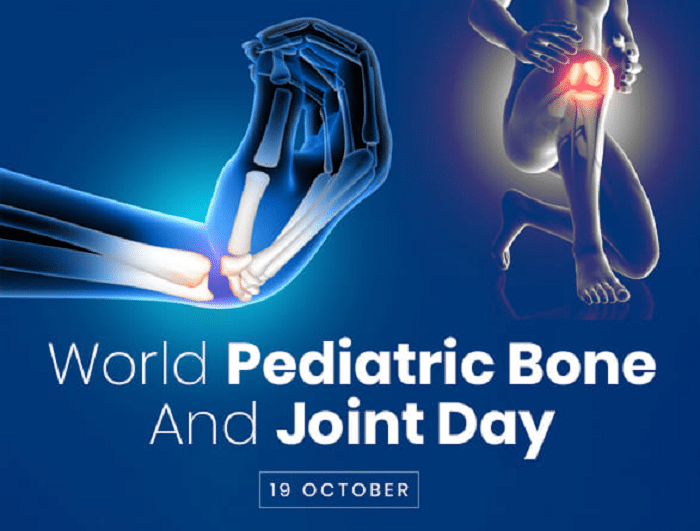World Pediatric Bone and Joint Day:
World Pediatric Bone and Joint Day, observed on October 19 each year, serves as a crucial reminder for parents about the importance of bone health in children. As children grow, their bones undergo significant changes, and ensuring that they have strong, healthy bones is essential for their overall development. This article will provide parents with key facts and insights to help promote bone health in their children.
Understanding Bone Health
Bone health is vital during childhood and adolescence, as these are the critical periods for bone development. During these years, bones are growing rapidly, and the right nutrition and physical activity can significantly impact their strength and density. Here are some fundamental aspects of bone health to understand:
1. Bone Development Stages
Children’s bones grow in several stages:
- Infancy: Rapid growth occurs, and bones are soft and pliable.
- Childhood: Bones continue to grow in length and density. This is the best time to build a strong bone foundation.
- Adolescence: The growth spurt typically occurs, and girls usually reach peak bone mass by around 18, while boys may continue to grow until about 21.
2. Peak Bone Mass
Peak bone mass is the maximum amount of bone tissue a person has, typically reached in late adolescence. Achieving a higher peak bone mass can reduce the risk of osteoporosis and fractures later in life. Parents should encourage healthy habits during childhood to help children reach their peak bone mass.
Key Nutrients for Healthy Bones on World Pediatric Bone and Joint Day
Nutrition plays a significant role in bone health. Ensuring that children receive the right nutrients is essential. Here are the key nutrients that contribute to strong bones:
1. Calcium
Calcium is a crucial mineral for bone health. It helps build and maintain bone mass. The recommended daily intake of calcium varies by age:
- Ages 1-3: 700 mg
- Ages 4-8: 1,000 mg
- Ages 9-18: 1,300 mg
Good sources of calcium include:
- Dairy products (milk, yogurt, cheese)
- Leafy green vegetables (kale, broccoli)
- Fortified foods (orange juice, cereals)
- Fish with bones (sardines, salmon)
2. Vitamin D
Vitamin D is essential for calcium absorption in the body. Without sufficient vitamin D, bones can become weak. The recommended daily intake for children is:
- Ages 1-70: 600 IU
Children can obtain vitamin D through:
- Sun exposure (15-30 minutes of sunlight daily)
- Fortified foods (milk, cereals)
- Fatty fish (tuna, mackerel)
- Supplements if necessary
3. Protein
Protein is vital for bone health as it helps in the growth and repair of tissues. Ensuring adequate protein intake is essential for children, especially during growth spurts. Good sources of protein include:
- Lean meats (chicken, turkey)
- Fish
- Eggs
- Legumes (beans, lentils)
- Nuts and seeds
Importance of Physical Activity
Regular physical activity is equally important for bone health. Weight-bearing exercises stimulate bone growth and help increase bone density. Here are some activities that can promote strong bones in children:
1. Weight-Bearing Exercises
Weight-bearing exercises involve activities where the body works against gravity. These include:
- Walking
- Running
- Jumping rope
- Dancing
- Playing sports (basketball, soccer)
2. Strength Training
Strength training, when done appropriately, can help build muscle and bone strength. Activities can include:
- Bodyweight exercises (push-ups, squats)
- Using resistance bands
- Light weights under supervision
3. Flexibility and Balance
Incorporating flexibility and balance exercises can help reduce the risk of falls and fractures. Activities such as yoga and martial arts can enhance balance and flexibility.
Risk Factors for Poor Bone Health
Several factors can contribute to poor bone health in children. Parents should be aware of these risk factors:
1. Nutritional Deficiencies
A diet lacking in calcium, vitamin D, and protein can lead to weaker bones. It’s essential to monitor children’s diets and ensure they are getting the right nutrients.
2. Sedentary Lifestyle
Increased screen time and a sedentary lifestyle can negatively impact physical activity levels. Encourage children to engage in regular physical activities and limit screen time.
3. Medical Conditions
Certain medical conditions, such as celiac disease, inflammatory bowel disease, or hormonal imbalances, can affect bone health. Regular check-ups with a healthcare provider are crucial to monitor any underlying issues.
4. Medications
Some medications may affect bone health. If your child is taking medication for a chronic condition, discuss with the doctor about any potential impacts on bone health.
Encouraging Healthy Habits
As a parent, fostering an environment that promotes healthy habits is vital for your child’s bone health. Here are some strategies to help:
1. Set a Good Example
Children often mimic their parents’ behaviors. Demonstrate healthy eating and active living by incorporating these habits into your own life.
2. Make Nutrition Fun
Encourage children to try new foods by making meals colorful and enjoyable. Involve them in meal planning and preparation to increase their interest in healthy eating.
3. Create an Active Lifestyle
World Pediatric Bone and Joint Day, Plan family activities that involve physical exercise, such as hiking, biking, or playing sports together. Make physical activity a regular part of your family routine.
4. Educate About Bone Health
World Pediatric Bone and Joint Day Teach children the importance of bone health in an engaging way. Use games or fun facts to help them understand how to take care of their bones.
Conclusion
World Pediatric Bone and Joint Day serves as an important reminder for parents about the vital role they play in promoting their children’s bone health. By understanding the key nutrients, encouraging regular physical activity, and being aware of risk factors, parents can help ensure that their children develop strong bones that will support them throughout their lives. Remember, investing in your child’s bone health today lays the foundation for a healthier tomorrow.

